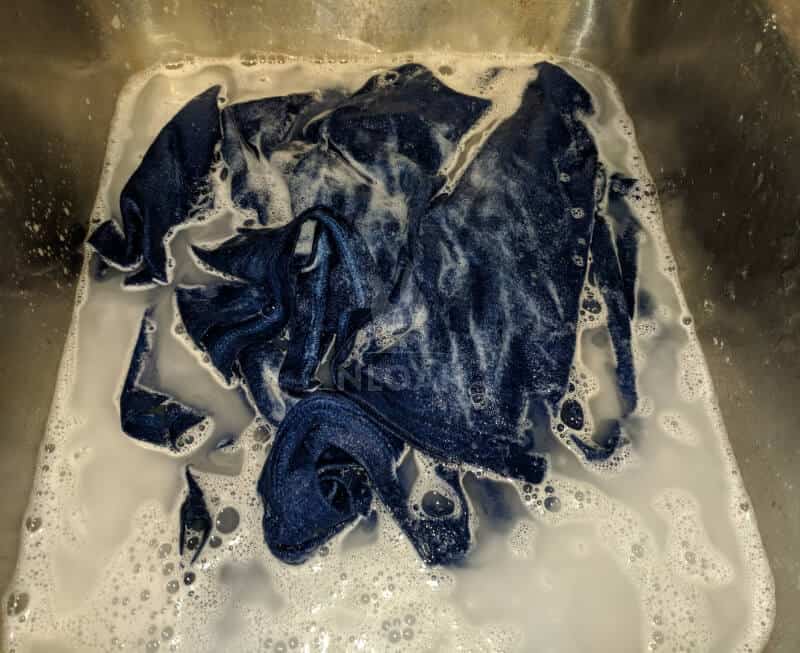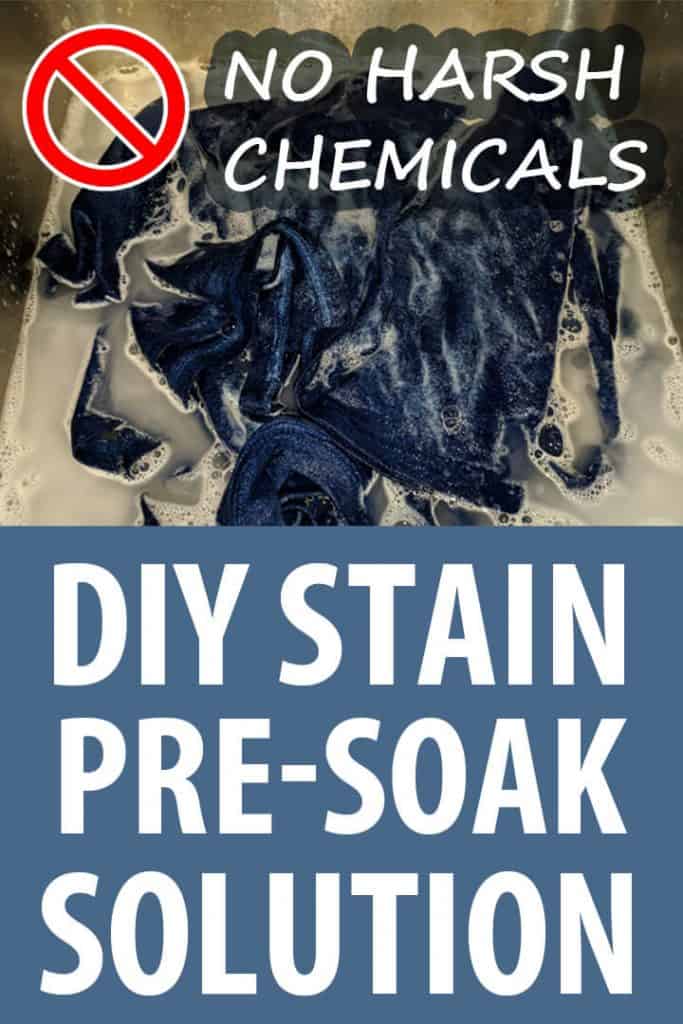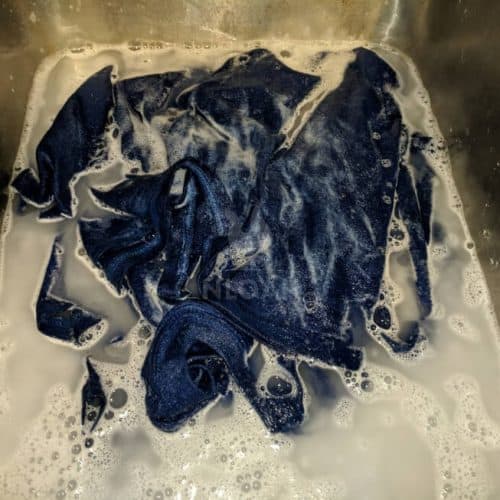Stop, do not pitch your little girl’s favorite dress, that blouse your splurged on, or your husband’s best dress shirt just because it has a big bad stain. You do not have to use harsh or potentially toxic chemicals found in a plethora of manufactured stain pre-soak products to get that stain out.
Natural DIY stain pre-soak solution recipes can combat even tough set-in stains just as well as those that contain synthetic ingredients that are difficult to pronounce.

Commercially manufactured stain remover pre-soak solutions could cause serious health woes, and cost at least triple what it would cost to make you own stain remover at home.
Toxins In Laundry Stain Removers
If you have read any of our other natural DIY cleaning recipes here on New Life On A Homestead (and I really hope you have!) you are keenly aware of two facts:
- Manufacturers are not required by law to name all of their ingredients on container labels because of proprietary laws – especially when pertaining to fragrances.
- The level of testing that goes into the synthetic ingredients we expose our families and pets to and how those results are tabulated on a health threat scale, might not be up to our personal safety standards.
Laundry product ingredients to be on the lookout for:
- Sodium Lauryl Sulfate and Sodium Laureth Sulfate/ Sodium Lauryl Ether Sulfate – These chemical compounds are perhaps the ones most commonly found in the majority of laundry room products – and also in shampoo, liquid hand wash, and dish soap. They are designed to be a foaming agents, and to lift dirt from surfaces. These sodium compounds were originally created to degrease garage floors. SLS and SLES compounds might cause inflammation to the lungs, skin, eyes, and damage various internal organs.
- Formaldehyde – If you are new to the world of natural DIY cleaners, it might be shocking to realize how often formaldehyde pops up in popular and common household cleaning products. Even low levels of exposure may enhance your risk of developing cancer, cause immune response inconsistencies, prompt spots of tissue decay. Tee EPA has deemed formaldehyde a B1 class probably carcinogen.
- Ammonium Quaternary Sanitizers or Quats – This chemical compound may cause lung, eye, and skin damage, yet it is commonly used in laundry products and other household cleaners that fill the shelves at big box stores.
- Phosphates – These synthetic ingredients often found in laundry products may cause osteoporosis, cardiovascular disease, and mineral poisoning of marine species.
- Benzyl Acetate -This laundry product additive may be harmful to not only the skin but to the central nervous system and to the kidneys if inhaled or spilled onto the body.
- Dioxane – 1,4 Dioxane/ Diethylene Dioxide/ Diethylene Ether/ Dioxane – These chemical compounds are possibly carcinogens, may cause lung, skin, and eye inflammation. It is possible the both fumes and liquid dioxane compounds can spontaneously combust. The fumes from these compounds may have a negative impact on the kidneys, respiratory system, liver, skin, and central nervous system.
- Bleach – Chlorine bleach, when inhaled, consumed, or absorbed can irritate not only the skin, but the lungs as well.
- Dichlorobenzene or P-Dichlorobenzene/ Benzene – This benzene may have an extremely and immediate toxic impact on marine life for many years after exposure. Fumes from this compound that comes with a carcinogen warning, might cause optical damage.
- Nonylphenol Ethoxylates or NPEs – This group of chemical compounds is also regularly used in many laundry products. NPEs mist or fumes may cause fatal damage when a person is subjected to prolonged exposure.
- Ammonium Sulfate – Oddly enough, this laundry product additive is not recommended for indoor use by manufacturers that use it in soil fertilizers. Unprotected exposure to ammonium sulfate can cause skin, respiratory, or skin problems. Gloves are supposed to be used when dealing with ammonium sulfate. Even empty containers of this chemical compound might cause damage to waterways.
- Fragrances and Dyes – The dyes and scents used to give color to laundry products do not contain any stain removal or cleaning power. They could cause skin rashes, allergies, may be carcinogens, and endocrine disruptors.
DIY Stain Pre-Soak Solution Recipe
Ingredients
- 1 quart cold water
- 3 tablespoons baking soda
- 2 tablespoons standard table salt or sea salt – double salt amount if treating a blood, wine, or ketchup stain
- ¼ cup 3% hydrogen peroxide
- 1 tablespoon liquid dish soap – optional but recommended and preferably or a DIY natural variety and not commercially manufactured
- 1 teaspoon cream of tartar optional but recommended for deep, tough, or set in stains
- 1 to 1 ½ tablespoons cornstarch if dealing with an oil or grease stain
Instructions
- Combine all of the ingredients in a squirt bottle or a tub the stained garment can be soaked in. You will need a spray bottle with a large nozzle, because the powdery ingredients can cause clogging.
- If using a spray bottle, firmly attach the nozzle and lid and shake vigorously for about 60 seconds. If using a soak tub or the sink, stir the DIY stain pre-soak solution recipe thoroughly for the same amount of time, but carefully to avoid splashing away your ingredients.
- Spray the stain on the garment liberally or place it in the soak tub and press it down so that it does not float. I recommend putting a bowl filled with cold water that has a firm fitting lid (like Pyrex) on top of the garment to prevent it from floating to the surface of the water.
- Allow the stained garment to absorb the natural DIY pre-soak solution for at least 10 minutes.
- Gently rub or dab the stain to spot being treated to help work it out of the fabric. Do this carefully to avoid spreading the stain.
- Allow the garment to soak for another 20 to 30 minutes for most stains, but up to five hours for blood, grease, oil, deep, or old stains – especially those on light colored fabric. If using the spray method, simply spray liberally again.
- Remove the garment from the soak and rinse it in cold water.
- Inspect the stain and repeat these steps if necessary.
- Launder in cold water, allow to air dry and inspect the stained area again to make sure it is gone. If you wash the garment in hot water and run it through the dryer, any remaining stain will be set in and make it that much more difficult to remove.
If the stain is still not entirely removed after completing all of the steps above, I recommend doing the following:
- Soak the garment in a mixture of 3 tablespoons of distilled white vinegar mixed with only enough of your natural laundry detergent to do a small load, and only water enough to cover the garment.
- Allow the mixture to settle overnight before rinsing with cold water and hang drying it.
- Once again, complete the pre-soak stain solution recipe steps one more time.
Never, ever, under any circumstances combine hydrogen peroxide and vinegar. Although both substances are natural, when mixed together they can form a toxic fumes that may cause up to severe health effects.
If you are removing a stain on a white garment, after using the DIY stain pre-soak solution, add about ½ of a cup of only one of the following:
- Lemon Juice
- 3% Hydrogen Peroxide
- Distilled White Vinegar
- Baking Soda
- Borax
Any of the items on the list above will help naturally whiten the previously stained garment, or any whites in your laundry load.


Tara lives on a 56 acres farm in the Appalachian Mountains, where she faces homesteading and farming challenges every single day, raising chickens, goats, horses, and tons of vegetables. She’s an expert in all sorts of homesteading skills such as hide tanning, doll making, tree tapping, and many more.

